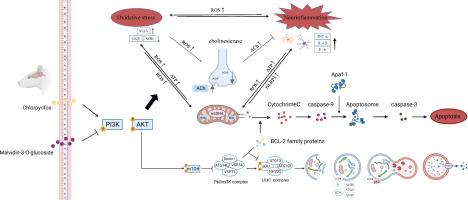Improvement of chlorpyrifos-induced cognitive impairment by mountain grape anthocyanins based on PI3K/Akt signaling pathway
IF 4.2
1区 农林科学
Q2 BIOCHEMISTRY & MOLECULAR BIOLOGY
引用次数: 0
Abstract
The organophosphorus insecticide Chlorpyrifos (CPF) is widely used worldwide due to its high effectiveness. However, when ingested through the mouth and nose, it can cause severe neurotoxic effects and cognitive impairment. Natural anthocyanins show great potential in improving cognitive impairment. In this paper, we will delve into the protective effect of anthocyanins on CPF-induced cognitive impairment and its mechanism through the PI3K/Akt signaling pathway. Morris water maze, histopathological, ELISA and western blot analyses showed that anthocyanins effectively ameliorated CPF-induced spatial learning memory impairment in mice by ameliorating CPF-induced AChE inhibition, oxidative stress, and neuroinflammation and by modulating the levels of apoptosis (Caspase-3, Caspase-9) and autophagy (LC3II/ LC3I, Beclin1, p62, mTOR) biomarkers, in order to restore damaged hippocampal tissue morphology, neuron and synapse structures. To identify the action pathway of anthocyanins, we used KEGG and GO pathway enrichment analysis for screening prediction and western blot and molecular docking to verify that anthocyanins improve CPF-induced cognitive impairment by activating the PI3K/Akt pathway.

基于 PI3K/Akt 信号通路的山葡萄花青素对毒死蜱诱导的认知障碍的改善作用
有机磷杀虫剂毒死蜱(CPF)因其高效而在全球广泛使用。然而,当通过口鼻摄入时,它会导致严重的神经毒性和认知障碍。天然花青素在改善认知障碍方面显示出巨大潜力。本文将深入研究花青素对氯化石蜡诱导的认知障碍的保护作用及其通过 PI3K/Akt 信号通路的机制。莫里斯水迷宫、组织病理学、ELISA 和 Western 印迹分析表明,花青素通过改善 CPF 诱导的 AChE 抑制、氧化应激和神经炎症,有效地改善了 CPF 诱导的小鼠空间学习记忆损伤、和神经炎症,调节细胞凋亡(Caspase-3、Caspase-9)和自噬(LC3II/ LC3I、Beclin1、p62、mTOR)生物标志物的水平,从而恢复受损的海马组织形态、神经元和突触结构。为了确定花青素的作用途径,我们利用KEGG和GO通路富集分析进行筛选预测,并通过Western印迹和分子对接验证了花青素通过激活PI3K/Akt通路来改善CPF诱导的认知障碍。
本文章由计算机程序翻译,如有差异,请以英文原文为准。
求助全文
约1分钟内获得全文
求助全文
来源期刊
CiteScore
7.00
自引率
8.50%
发文量
238
审稿时长
4.2 months
期刊介绍:
Pesticide Biochemistry and Physiology publishes original scientific articles pertaining to the mode of action of plant protection agents such as insecticides, fungicides, herbicides, and similar compounds, including nonlethal pest control agents, biosynthesis of pheromones, hormones, and plant resistance agents. Manuscripts may include a biochemical, physiological, or molecular study for an understanding of comparative toxicology or selective toxicity of both target and nontarget organisms. Particular interest will be given to studies on the molecular biology of pest control, toxicology, and pesticide resistance.
Research Areas Emphasized Include the Biochemistry and Physiology of:
• Comparative toxicity
• Mode of action
• Pathophysiology
• Plant growth regulators
• Resistance
• Other effects of pesticides on both parasites and hosts.

 求助内容:
求助内容: 应助结果提醒方式:
应助结果提醒方式:


